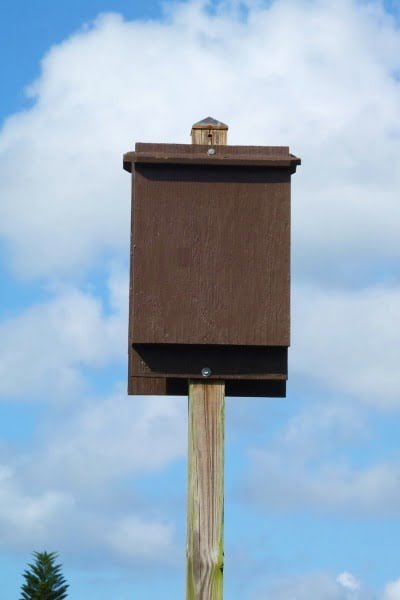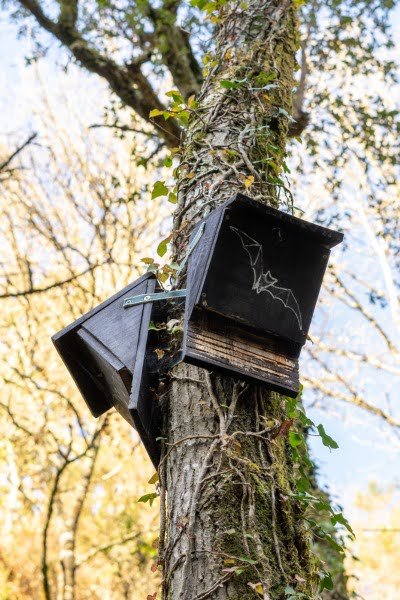If you’ve ever wondered about attracting bats to your property, you’re not alone. Bats, often misunderstood, play a crucial role in maintaining a balanced ecosystem. While you might not want them as houseguests, encouraging bats to take up residence in a well-placed bat house can offer a plethora of benefits to your environment and garden. Bats are skilled pollinators, seed distributors, and adept insect hunters, making them your nocturnal allies in the battle against pesky insects. In this comprehensive guide, we’ll answer some frequently asked questions about attracting bats to your bat house.
Check out 20 DIY Backyard Ideas on a Budget for Stunning Gardens Click here...

Signs of Bat House
Spotting signs of bat residence can be a thrilling moment for a bat enthusiast. Common indicators include:
- Bat Droppings: These might resemble moose droppings and are a clear sign of bat activity.
- Urine Stains: Look for urine stains on your walls or ceiling, a telltale mark of bat presence.
- Nocturnal Noises: Unusual scratching or squeaking noises, usually heard at night.
- Exit and Entry Points: Keep an eye out for black, oily streaks near potential entry or exit points.
If you suspect bats have taken up residence in your home, consider installing a bat house as a humane alternative.
Occupancy Monitoring
How can I tell when bats are in the house?
The most definitive sign is finding bat droppings around the bat house. You can also observe the house at night during their peak activity hours, but avoid reaching into it directly, as bats may react aggressively if provoked.
Maintenance and Cleanliness
Do I have to maintain or clean my bat house?
Regular maintenance and cleaning are essential for the bat house’s functionality. Ensure at least annual maintenance and keep an eye on it a couple of times per month. Leakage, drafts, and deterioration can deter bats from using it, so make repairs when the house is unoccupied.
Number of Bat Houses
How many bat houses should I put up?
The number of bat houses needed depends on the local bat population. Consider proximity to resources like water. Bats prefer living in colonies, and several hundred can reside in a single bat house.
Check out Electroculture Gardening: Boosting Plant Growth with Electricity Click here...
Helping a Fallen Baby Bat
A baby bat fell out of the bat house. What should I do?
Gently capture the bat with gloves and place it near a heat source to keep it warm. Monitor it for injuries or illness and contact your local wildlife rehabilitator for assistance.
Legal Considerations
Are there laws or restrictions in the USA against putting up bat houses?
There are no restrictions on putting up bat houses on your own property. If you wish to install one on public property, seek permission from a designated representative.
Pest Control by Bats
How effective are bats at controlling insects?
Bats are nature’s mosquito police, feasting on mosquitos, certain worm species, beetles, moths, grasshoppers, and other pests. A single bat can consume hundreds to thousands of insects in a night.
Check out Creative DIY Tree Projects: From Tree Rings to Guards Click here...
Bat House Occupancy
How many bats can potentially occupy my bat house?
The number of bats depends on local bat populations and the house’s size and condition. In areas with a high bat population, clean, well-maintained bat houses can host several hundred bats.
Hibernation Period
When do bats hibernate?
Bats typically hibernate from fall to early spring in dark and secluded places, conserving energy during this period. They choose hibernation sites like homes, caves, trees, barns, attics, and crawl spaces.
Bat House Placement
How high should the house be?
As flying mammals, bats prefer high locations for their houses, ideally between 12 to 20 feet above the ground. Ensure it’s at least 20 to 30 feet away from trees to protect from aerial predators.
Safety Considerations
Will bats harm people, pets, or birds?
Bats generally avoid harming people, pets, or birds but may do so if disturbed. Clean or repair the bat house only when bats are absent.
Check out Creative Ideas for DIY Indoor Plant Projects Click here...
Bat Diet
What do bats eat?
Bats in the United States and North America primarily consume mosquitos, certain worm species, beetles, moths, grasshoppers, and other pests. Some species prefer fruit, nectar, and pollen, serving as pollinators.
Cleaning Your Bat House
Should I clean my bat house?
Clean bat houses in winter when unoccupied to extend their lifespan and prevent wasp nests. Monthly monitoring and occasional cleaning are usually sufficient.

Ideal Placement
Where should I place my bat house?
Place your bat house near a water source, at least 10 feet above the ground, in an unshaded region. Avoid positioning it next to trees or structures that may block sunlight or harbor predators.
Risks and Rabies
What about rabies?
While rabies risk from bats has decreased in developed countries due to animal vaccination, exercise caution when encountering a sick or dead bat. Contact your local wildlife center for assistance.
Build or Buy a Bat House
Build or Buy a Bat House?
You can either build your own bat house using online tutorials or purchase one at an affordable price. The design and construction quality are crucial; an inadequate bat house won’t attract bats.
Bat Species
Do I have bats in my area?
Bats inhabit regions worldwide, including the US and Canada. The most common species in the US are the Big Brown Bat and the Little Brown Bat.
Check out How to Make Your Mass Cane Plants Bloom: A Guide for Gardeners Click here...
Handling Bat Guano
What should I do with the bat guano?
Bat guano, their droppings, can be used as fertilizer in some cases, but be cautious, as it may carry pathogens. Contact a professional wildlife control center to handle it safely.
Attracting Bats
How do you attract bats to your new bat house?
Place your bat house in an optimal location, preferably near night-scented flowers that attract moths, a favorite bat prey. Avoid spreading bat droppings, as it doesn’t necessarily attract bats and may pose health risks.

Bat Box Benefits
Are bat boxes a good idea?
Bat boxes offer numerous benefits. Knowing potential risks minimizes chances of injury or illness.
Attracting Bats: Location Matters
Do bat houses attract bats?
Location is crucial for attracting bats. Properly placed bat houses on high surfaces tend to attract more bats. Proximity to a water source can also enhance their appeal.
Disadvantages of Bat Houses
What are the potential health risks associated with bat guano (droppings)?
Bat guano can carry dangerous pathogens, including Histoplasma Capsulatum fungus, which can pose health risks to humans. When handling bat guano or cleaning bat houses, it’s essential to take precautions to minimize the risk of exposure. Consider seeking professional assistance for safe removal and handling of guano.
For more information on the benefits of bats and bat conservation, visit batcon.org.
Remember, attracting bats to your bat house can be a rewarding and environmentally beneficial endeavor. Your well-placed bat house can make a significant difference in pest control and supporting these vital, often misunderstood creatures.
Pingback: 17 Best Types of Yucca Plants & How to Care for Them -
Pingback: Growing Loofah Gourds: A Guide to Cultivate and Harvest Your Own Sponges
Pingback: Bulb Planter: Essential Tools for a Flourishing Garden